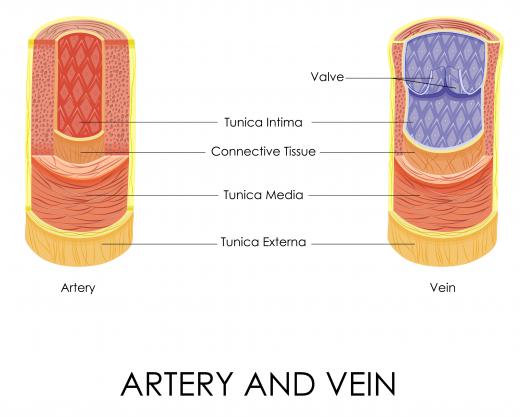What is Extracellular Protein?
An extracellular protein is a peptide that resides in body fluids outside of cells. Extracellular fluids include interstitial fluid, or the fluid between cells; plasma, the fluid portion of blood; and cerebrospinal fluid, the fluid that bathes the brain and spinal cord. An extracellular protein can function in enzymatic action and cell recognition or signaling. Together with other organic compounds and ions, extracellular protein is important in maintaining water balance in the intracellular and extracellular spaces by acting as solutes.
A solute is any molecule or compound dissolved in a fluid. A fluid containing a solute is called a solution, and it can be characterized as being hypotonic, hypertonic, or isotonic. Tonicity reflects the amount of solute in a solution. A hypotonic solution has a low solute to fluid ratio. A hypertonic solution has a high solute to fluid ratio, and an isotonic solution has an equal solute to fluid concentration.

Extracellular proteins called plasma proteins are especially important in determining tonicity and fluid movement due to their ability to create oncotic pressure. While cell membranes are readily permeable to water, not all solutes will diffuse easily across cell walls. Water will, however, flow in or out of cells from an area of lower solute concentration to an area of higher solute concentration in order to achieve balance in the body.
For example, when blood flows through a capillary, the high pressure at the arterial end pushes fluid through the capillary wall. This hydrostatic pressure creates a filtration process that leaves mostly plasma proteins and some cells behind in the lumen of the capillary. The cells and proteins are non-diffusable because they are either too big or too polar to cross the vessel walls.
The blood inside the capillary now contains a high amount of solute in comparison to its fluid concentration. This is a hypertonic solution. So, the water wants to flow back into the capillary lumen because the fluid in the interstitial space is exerting a high amount of pressure on the outside capillary walls, and the protein rich solute is drawing the water in to dilute it. The force of the protein drawing water to the hypertonic solution is oncotic pressure.
In some cases, there is a low level of extracellular protein in the plasma. This is known as hypoproteinemia. When this occurs, fluid does not readily flow back into the capillary because there is not enough plasma protein to exert pressure. Instead, the fluid pools in the tissue spaces, causing edema.
AS FEATURED ON:
AS FEATURED ON:











Discussion Comments
@Iluviaporos - Yeah, I always feel good about humanity when you see how people try to help after something like that happens, but there are little kids with cancer who can use plasma right now, so it's always a good idea to give.
I guess, because plasma doesn't have anything complicated like cells in it (although as it says in the article, it does have some proteins and things) it's easy for your body to remake it quickly so there's no excuse for the average person.
They say that after a big disaster, like 9/11 or Katrina, that the blood bank has to turn people away, because whole blood only lasts so long (I think it's about a month) and lots of people want to feel like they are doing something to help in the aftermath.
But, if you really want to help, it's better to give regularly, rather than just when something big is happening, and to give plasma. Because it's outside of cells, plasma can be frozen (unlike whole blood, where the red cells are damaged if they are frozen) so it can be stored for a lot longer.
I try to give every few weeks and it's my plasma (and everyone else who gives regularly) that will be rushed to the sites of emergencies, because of that. Which is not to say that you shouldn't give whenever you feel the need, but if you do it right now, that's better than waiting until after something has happened.
Post your comments